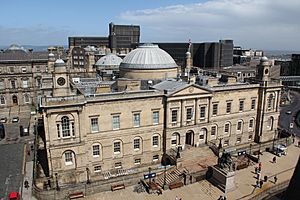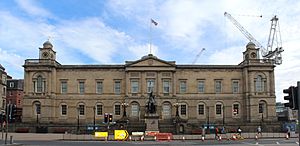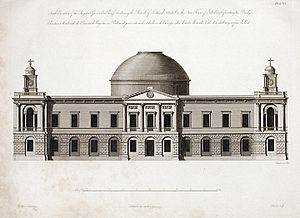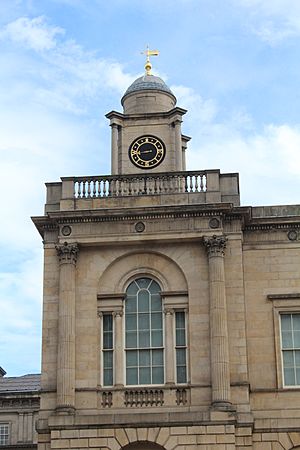General Register House facts for kids
General Register House is a very old and important building in Edinburgh, Scotland. It's located on Princes Street and was built a long time ago, between 1774 and 1788. A famous architect named Robert Adam designed it.
This building was made to be the main home for the National Archives of Scotland. Think of it as a giant, super-safe library for all of Scotland's most important historical papers and records. It's so special that it's officially known as a "Category A listed building," which means it's a really important part of Scotland's history and architecture.
Contents
Building Design and Features
General Register House has a unique shape, like a square with a courtyard in the middle. It's built from polished, cream-coloured sandstone, which is a type of rock. The building has two main floors and a slightly lower basement level.
The ground floor and the upper parts of the corner sections have arched openings with windows. These windows are the traditional "sash window" style, with twelve small glass panes. The building also has decorative stone lines and patterns that make it look grand.
Corner Towers and Central Dome
At each corner and in the middle of every side, there are parts of the building that stick out and are a bit taller. These are called "pavilions." The corner pavilions at the front have a square top with a small, round dome called a cupola. They also have a weather vane (to show wind direction) and a clock.
In the middle of the courtyard inside the building, there's a special round room used for reading. This room has a large dome on top. The inside of this dome was decorated with beautiful designs by Thomas Clayton in 1785.
Front Entrance and Decorations
The front of the building is very impressive. It has thirteen sections, with the corner parts standing out. The upper windows on the corners are special, with a "Venetian window" style, which means they have three parts.
The main entrance is right in the middle of the front. You walk up a grand staircase to get to it. The entrance is framed by four tall, fancy columns. Above the entrance, there are decorative panels with patterns and the royal coat of arms of the United Kingdom, which is the official symbol of the British royal family.
Inside the Building
The roof of General Register House is made of slate, except for the central dome, which is covered in lead. Inside, the building has staircases at both ends, and they now have lifts (elevators) to help people move between floors.
One important room is the "Lord Clerk Register's room," which is behind the main entrance. It has a fancy fireplace made of grey marble. Beyond the central dome, there's a room called the "Historical Search Room." This room used to be called the "Antiquarian Room" and has two floors of wooden bookshelves and a ceiling with decorative patterns.
Building Care and Updates
Over the years, General Register House has been looked after and updated.
- In 1969, the stone outside was cleaned.
- The decorations inside the dome were repainted in 1973 and 1974.
- In 1993, the main entrance hall was restored and changed a bit, and a new fireplace was put in.
Images for kids








